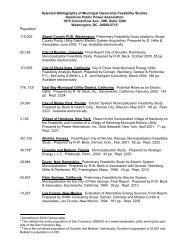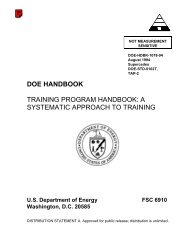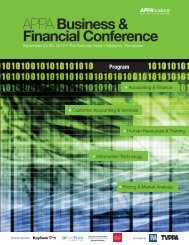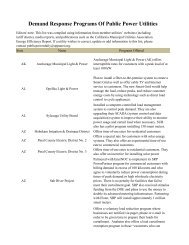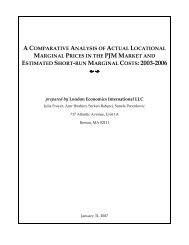View Complete Issue - American Public Power Association
View Complete Issue - American Public Power Association
View Complete Issue - American Public Power Association
You also want an ePaper? Increase the reach of your titles
YUMPU automatically turns print PDFs into web optimized ePapers that Google loves.
A daily news service of the <strong>American</strong> <strong>Public</strong> <strong>Power</strong> <strong>Association</strong> February 22, 2008FERC proposes limited changes in centralized marketsThe Federal Energy Regulatory Commission proposed new rules Feb. 21 to make a number ofdiscrete changes to the centralized markets run by regional transmission organizations, butrejected a request by APPA and 40 other organizations to investigate whether the RTO-runwholesale electricity markets are producing just and reasonable rates. Perhaps the most notablepart of the proposed rule is a directive that all RTOs develop proposals for scarcity pricing whenreserves are tight.The scarcity pricing plans presumably would entail lifting or substantially raising caps on prices inthe RTO-run markets during operating reserve shortages. A commission press release said theproposal calls for modifying “market rules to allow market-clearing prices, during a period ofoperating reserve shortage, to reach a level that rebalances supply and demand so as tomaintain reliability while providing sufficient provisions for mitigating market power.” Thecommission characterized the scarcity pricing directive as a demand-response mechanism.The proposed rule is limited to changes in four areas: demand response; long-term contracting;market monitoring; and RTOs’ responsiveness to customers and stakeholders.“I believe competitive wholesale markets are operating well, and that wholesale competitionpolicy has been a success,” FERC Chairman Joseph Kelliher said. “I believe it represents thebest means of assuring security of our electricity supply going forward and the best means ofmeeting the climate change challenge.” The proposed rule “does not represent the last word oncompetition policy,” he said, adding that “we will act to make improvements on a structural basisin both the organized markets and bilateral markets, and we will act on a national basis.”“I think the criticism [of the RTO-run markets] is driven largely by prices,” Kelliher said. “Butcurrent electricity prices are driven largely by the cost of fuels,” notably natural gas and coal.In addition to proposing changes to RTOs’ market rules, FERC ordered its staff to hold atechnical conference to address two specific proposals, one by the <strong>American</strong> Forest and Paper<strong>Association</strong> and one by the Portland Cement <strong>Association</strong> and other industrial customers, to makesignificant changes to the design of the centralized markets. The commission said it encourageseach RTO to provide a forum to consider any specific proposals from consumer organizations orother entities to strengthen competitive markets.“While we welcome any incremental improvements to the centralized markets run by RTOs, wecontinue to believe that the facts—the high prices in those markets compared to the rest of thecountry—warrant fundamental reforms,” said APPA Senior Vice President-Government RelationsJoe Nipper. “FERC ignores those facts at the peril of millions of consumers.”“We understand that natural gas and coal prices are high; not-for-profit public power utilitiesoperate throughout the country,” Nipper said. “But high natural gas prices do not fully explain orjustify the excessively high electricity prices in these centralized markets or the fact that prices
are going up much faster in the RTO markets. We also understand that power plant constructioncosts are going up; public power utilities are building power plants too.”“APPA welcomes Chairman Kelliher’s remarks that the commission will continue to makeimprovements in both the centralized RTO markets and bilateral markets,” Nipper said. “We alsocommend the commission for planning to hold a technical conference on the proposals by the<strong>American</strong> Forest and Paper <strong>Association</strong> and Portland Cement <strong>Association</strong> to reform the RTO-runmarkets. As [APPA President and CEO] Mark Crisson told state regulators, a collaborativeprocess where all stakeholders can share and shape ideas is a better approach than FERCplaying a game of ‘bring me a rock.’” [In that game, without being given any guidelines, you keepbringing rocks to someone until they get one they want. See the Feb. 20 <strong>Public</strong> <strong>Power</strong> Daily.]“We remain disappointed that the commission continues to take a narrow, restricted approach toits obligation to ensure that electricity rates are just and reasonable,” Nipper said. “And we see nofactual support for assertions that these incredibly complicated markets are operating well.”The commission’s primary proposal for improving long-term power contracting in RTO-runmarkets would require RTOs to set aside a portion of their Web sites for market participants topost offers to buy or sell power on a long-term basis.Proposed changes to RTOs’ market monitoring rules largely track the recent settlement betweenPJM and its market monitor, with provisions on access to data, sufficient resources and reportingdirectly to the RTO board. The proposed rule would remove market monitors from administeringmarket mitigation measures.The proposed rule would reduce the time period before RTO market bid and offer data arereleased to the public, the commission said. Details were not available as <strong>Public</strong> <strong>Power</strong> Weeklywent to press. APPA has recommended that the bid and offer data, with generation sourcesidentified, be released within one day.On RTO responsiveness, the proposed rule calls for RTOs to adopt principles to ensureinclusiveness, fairness among diverse interests, representation of minority positions, and ongoingresponsiveness.Comments on the proposed rule, Wholesale Competition in Regions with Organized ElectricMarkets, are due 45 days after it is published in the Federal Register.Schori calls on utilities, energy consumers to worktogether to reduce demand, environmental impactsElectric utilities need to work with their customers to change energy consumption behaviors thatadversely impact the environment, the general manager of the Sacramento Municipal UtilityDistrict told a national conference Wednesday.“They want cleaner air, but they are reluctant to turn down their air conditioners on a hot day inJuly and they love their flat screen TVs,” said SMUD General Manager Jan Schori at the NationalElectricity Delivery Forum in Washington, D.C.“It is time for the utility industry to move beyond customer satisfaction,” she said. “Now, we needto ask them to understand more fully the impact their energy use has on the grid and on theenvironment. We need to engage them and help them, and get them to help us work on local airquality issues and lower greenhouse gas emissions.”
The conference was cosponsored by the U.S. Department ofEnergy and the National <strong>Association</strong> of Regulatory UtilityCommissioners. Schori was one of five CEOs on a paneladdressing how electric utilities can respond to uncertaintiesassociated with climate change, demand growth and energysecurity.SMUD worked with more than 30 consumer focus groups last yearand found that customers want to be more efficient, but also wantoptions and control, Schori said.It is time for consumers towork with utilities to reduceenergy demand andadverse impacts on theenvironment, Jan Schori,general manager of theSacramento MunicipalUtility District, toldaudience members at anational conference onWednesday.“The focus groups told us that time-of-use rates are viewed as arate increase,” she said. Utilities need to be cautious whenmarketing demand-response alternatives; customers using theleast energy are those who have to —low-income customers, shesaid.But it’s not consumers, alone, who are inevitably responsible, shesaid. SMUD spent $34 million on energy efficiency initiatives lastyear and will spend $40 million next year on investments in addedtransmission and renewables—namely, turning to biomass, greaseand food waste, landfills and solar energy.In addition, California legislators have enacted a tough emissionsmandate: one that requires utilities to play their part in bringingstate greenhouse gas levels down to 1990 levels by 2020.<strong>Public</strong> <strong>Power</strong> Daily is produced by the editorial staff of <strong>Public</strong> <strong>Power</strong> Weekly newsletter.Subscribers are prohibited from reproduction of this publication by any means, including facsimileor e-mail transmission, without the express permission of the <strong>American</strong> <strong>Public</strong> <strong>Power</strong> <strong>Association</strong>,except that it may be reproduced and/or redistributedto employees or board members of their own organizations.Questions or comments about editorial matter should be directed to Jeannine Anderson(janderson@APPAnet.org, or call 202/467-2977). Subscription inquiries should be directed toLaurel Lundstrom (llundstrom@APPAnet.org, or call 202/467-2946). Members of APPA can subscribefor $145/year for e-mail delivery, $285/year for delivery via fax. The subscription price for non-membersis $290/year for delivery via e-mail; $570/year for delivery via fax.Copyright © 2008, <strong>American</strong> <strong>Public</strong> <strong>Power</strong> <strong>Association</strong>






